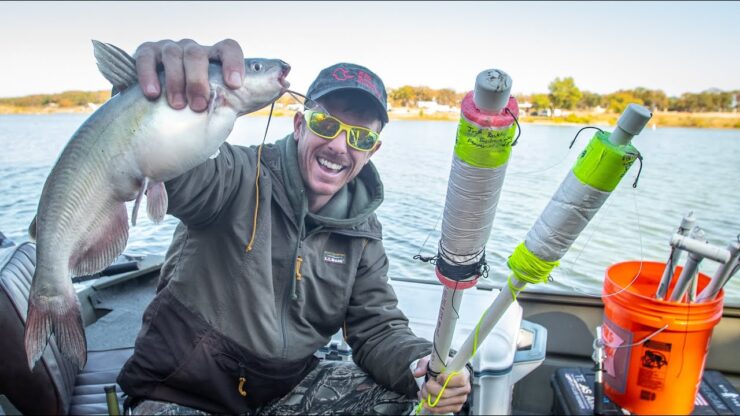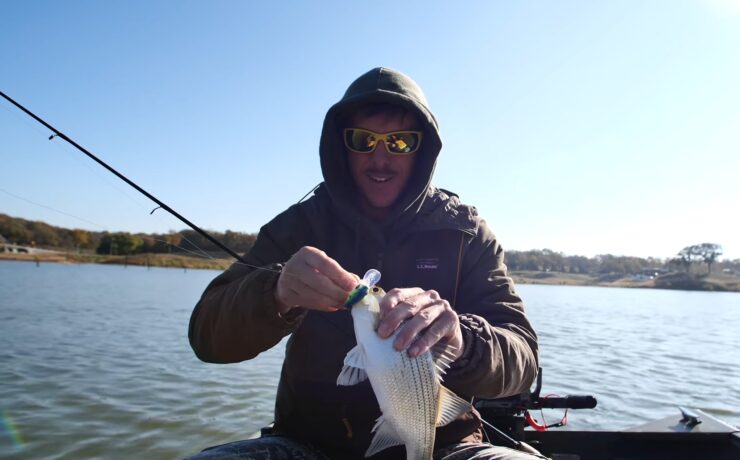Jug fishing is an extremely popular method of catching catfish today. Catfishing, in general, is very popular; in fact, it’s the most widely practiced freshwater sport fishing activity in North America (Buckley et al., 2000).
Most people choose jug fishing over other methods for catfishing because it’s productive and affordable. It doesn’t require much in terms of equipment or expertise, especially in comparison with other types of catfishing that may involve expensive electronics, special boat modifications, or hiring an expensive guide.
Jug fishing only requires the basics: a strong line (50 lb test or higher), large treble hooks (size 6/0 to 10/0), heavy sinkers (1-2 lbs), and big live fish bait like carp or buffalo fish; stink bait can also be effective. Since these lines are generally lighter and the bait smaller, you can use jug lines in features like brush piles and laydowns where heavier catfish setups wouldn’t work.
Jug fishing is extremely popular because it works: channel and blue cats (the two most common species) often feed low and slow along the bottom, using their whiskers to search for prey.
Safety Precautions To Take When Jug Fishing

Catching fish by hand is dangerous because you can’t really see what you’re doing, partly due to darkness but especially when the water conditions are murky. Getting stabbed by the gills or spines of certain fishes (e.g., gar, catfish) is not only painful but can be very dangerous to your health.
Never reach into a hole, crevice, or under anything without knowing what’s there; hold on to something if you’re uncertain about what’s in front of you. If you’re in shallow water with slippery rocks and the depth below you isn’t known, then it’s best to kneel or sit down when fishing with hand-made lures.
If using an auger in muddy water, tie heavy objects onto your shirt before beginning so that if you fall through the surface of the muck layer (or drop the tool), these items will weigh you down so that you can get back up and climb out.
How to fish with jugs
When using a jug line, be aware of the possible underwater hazards in your area: submerged trees and stumps, logs, rocks, and so on.
Before fishing with live bait, you must consider the safety of both yourself and your catch. Even though some fish are non-venomous or relatively harmless (e.g., carp), getting bitten is still unpleasant if not life-threatening.
Certain fishes have sharp spines that can pierce through flesh very easily; others are poisonous or toxic to the touch – e.g., stonefish, some species of lizardfish/marine iguana/iguanid eel, some species of scorpionfish.
It doesn’t matter how big or small these spines are; even if it’s just a little cut, bacteria can enter the body and cause infection. So always be wary of what you catch when fishing with live bait in areas where poisonous fishes exist.
Although most freshwater stingrays will not attack you unless provoked, they have been known to come in contact with jug lines or hand-made lures that are used by anglers fishing for catfish, so it is important that stingray safety is considered before beginning this activity.
Stick your hand underneath them slowly when removing them from the water – don’t attempt to grab them by their tails. Be especially cautious when handling cownose rays (Rhinoptera bonasus) because they have very sharp barbs on their tails and mouths, and also tend to be aggressive.
If you’re fishing for catfish in an area where freshwater stingrays are known to exist, it is best to keep your line or net submerged. This way, if a ray comes in contact with your gear (especially when using live bait), the animal will get caught up in the line instead of you.
The most important things to know when fishing with jugs

When catching fish by hand or jugging, understand that these animals might thrash around quite aggressively; they may bite or lash out at you while trying to escape. However, don’t let this intimidate you because all of the proper safety precautions have been taken (e.g., gloves and/or gauntlets worn). It’s important that you stay calm and collected at all times when fishing because panic can lead to accidents.
In addition, avoid using jug lines or hand-made lures in areas where water currents are strong and/or there is a significant amount of boat traffic because the fish will be swept away quickly. If possible, use weighted hooks so that once you catch something, it won’t get dragged away too fast from your location.
Also, weigh down your line with an object so that it doesn’t drift far from your position – e.g., if you’re on a bank by the waterside, tie the other end to a tree or root sticking out of the ground; if you’re standing in a boat anchored somewhere, then bury some weights into the bottom of the vessel before dropping the jug line.
Conclusion
The number one thing to remember when fishing for catfish with hand-made lures like jugs is that this activity requires skill and patience. It takes time before the fish bites on your line; be patient while waiting – do not begin reeling in your line quickly because this makes it harder for the catfish to get its mouth around the hook/sinker.
If you feel that the weight of your bait is not keeping it submerged underwater, then attach a weight to the line (e.g., fishing sinker). If you can’t feel anything on your line (i.e., no bites), reel in one or two feet of line and wait for a few minutes before dropping it back down again; doing this repeatedly may help – e.g., if there was no fish biting on the jug after thirty minutes, then try again after five minutes and see what happens.
Adelaide Gentry, a seasoned kayaking enthusiast and expert, is the driving force behind KayakPaddling.net. With over a decade of experience navigating the world’s most challenging waterways, Adelaide combines her passion for adventure with a deep knowledge of kayaking to provide insightful and practical guidance for paddlers of all levels.
Related Posts:
- 14 Best Fishing Line for Baitcaster 2024 - For…
- 9 Best Backpacking Fishing Rods 2024 - Lightweight…
- 10 Best Fishing Reel for Salmon 2024 - Reels for Big Gamers
- 10 Best Saltwater Fishing Boats - Ultimate Angling Adventure
- 12 Best Walleye Rods 2024 - Professional Fishing Gear
- 10 Best Kayak Fishing Net for Anglers 2024 - Top Picks












